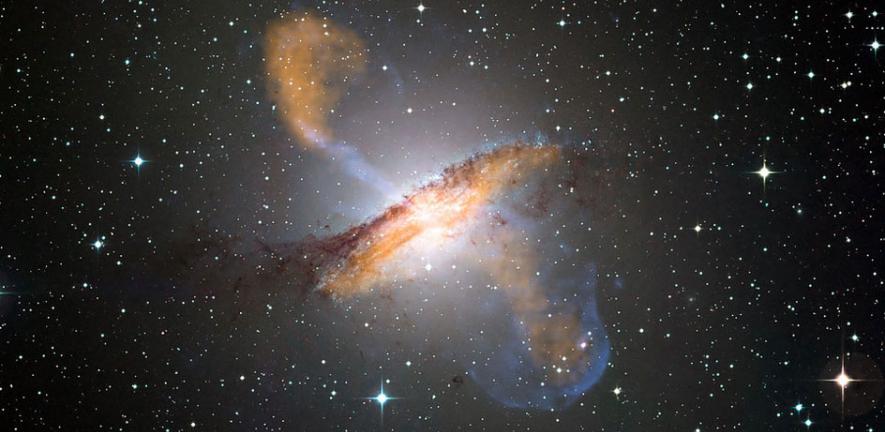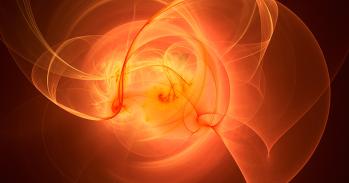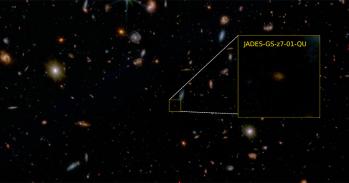
Paul Murdin from the Institute of Astronomy put a human face to the names behind some of the greatest discoveries to have taken place in our efforts to understand the mysteries of the cosmos.
Paul Murdin from the Institute of Astronomy put a human face to the names behind some of the greatest discoveries to have taken place in our efforts to understand the mysteries of the cosmos.
The history of astronomy is littered with these very human stories.
Isaac Asimov suggested that the most exciting phrase one can hear in science is not the "Eureka" famously yelled by Archimedes, but rather a more quizzical, "that's funny". It's not surprising to find Paul Murdin, whose recent book "Secrets of the Universe" followed some of history's greatest astronomers, in hearty agreement.
Murdin's aim in writing the book and in discussing it at Hay yesterday afternoon was to show how humanity has made sense of the cosmos (insofar as it has at all) thanks to great technological leaps, but only when curious minds then turned that technology skywards. The puzzlement encapsulated in the phrase, "that's funny" is revealing because it shows us what a very human story it is. Often astronomers knew what they were trying to find, but more often, they didn't know what they were looking for until they found it, or only found it when they were looking for something else.
The variety of stories Murdin picked out for his audience also revealed some unsung heroes. One is Thomas Harriot, an English polymath who turned a telescope to the sky before anyone else early in 1609, almost a full year before Galileo, who is normally celebrated as the innovator in this regard. Sadly, less is known of his observations because he wrote nothing down. Murdin believes that this was because he had fallen under suspicion during the Gunpowder Plot some years earlier and, although he had been cleared of any involvement, was still under suspicion. "He felt that people were keeping an eye on him and that he had too much to lose," Murdin said. "We know far less about him than he deserves."
Galileo, on the other hand, would figure instantly in any scientist's top 10 list of favourite scientists, Murdin reckons. He capitalised on the invention of the telescope 400 years ago using natural curiosity and an endearing refusal to take anyone's word for anything. In this sense he sets a precedent for modern scientists, demanding that any consensus at the discipline's cutting edge is reached through the gathering of evidence and careful (often animated) discussion. Controversially, Galileo found that the Earth was not the first in a series of planetary steps towards heavenly perfection, discovered that Venus was orbiting the Sun, that Jupiter was being orbited by moons and that, most dangerously of all, Earth was therefore not at the centre of the solar system. In the face of the Inquisition, he was forced to renounce many of these truisms.
The same tale, of technology given full flight by human curiosity, characterises the story of the radio telescope in the 20th century. This grew out of radar, a famous technological pay-off of World War II, with which natural phenomena were discovered to be interfering. Defence scientists returning to their universities after the defeat of Nazi Germany therefore set about their next challenge, to solve assorted mysteries of the Universe. Chief among them was Martin Ryle, who was able to differentiate between brighter, closer galaxies and more distant, fainter examples. From this, he discerned that the more distant galaxies (which astronomers were therefore viewing further back in time, because it takes longer for the light from those stars to reach us), were closer together. The universe, Ryle then realised, had evolved from a more compacted state into what it is now. This theory of expansion is now popularly understood as the Big Bang.
Antony Hewish, who shared a Nobel Prize with Ryle, was researching this theory further by examining the "twinkling" of these distant stars when his PhD student, Jocelyn Bell, uncovered what she called "a bit of scruff" in the data. Bell could easily have overlooked this anomaly - indeed Murdin implied a less thorough scientist might have done so - but her conscientiousness and curiosity conspired to get the better of her. The sources were discovered to be celestial - stars of about the same mass as the sun but no bigger than 10km in radius, which were rotating rapidly with the effect that a radio beam was sweeping across the Earth. The discovery, of pulsars, was attributed to Hewish who won the Nobel Prize jointly with Ryle some years later. This has led to a controversy over Bell's input which has ultimately redefined the basis on which the Prizes are awarded.
The history of astronomy is littered with these very human stories. Another is that of Caroline Herschel, sister of William, who moved to join her brother and contribute to his astronomical research in Bath only after overcoming strong opposition from the rest of her family, who wanted her to do something useful, like sewing. For years, her talents were suppressed by relatives in a manner which would seem almost criminal to us now, but she eventually made it to England from her native Hanover, and aided William in the discovery of Uranus before discovering a comet in her own right. Both were eventually honoured by the court of George III and became respected astronomers. Even then, however, Caroline only earned a pension half that of her brother. On doing so, at the age of 37, she reflected that it was the first time in her life that she had earned money to spend as she pleased. In some ways her story feels like a foreshadowing of the rather different obstacles later female scientists, like Bell, had to overcome.
Not all astronomers succeed by virtue of serendipity alone, of course. The Frenchman Urban Le Verrier knew exactly what he was looking for when he found Neptune with the aid of a German colleague, beating the Englishman John Couch Adams to it largely thanks to the rather lacklustre support that the latter received in England. Le Verrier was able to work out which part of the sky he should be looking at to find another planet, because he (and Adams) had both noted that Uranus was deviating from its predicted orbit because of some other, unseen gravitational force - presumed, rightly, to be that of another planetary body. It was, as was later observed, a discovery "made at the end of his pen and by force of calculation". More Eureka than funny, in that particular case.
In spite of these achievements, current scientific thinking suggests that 96% of the Universe remains beyond our present powers of comprehension. Murdin believes that some of the biggest questions may be solved over the course of the next generation or two. In particular, the Large Hadron Collider has the potential to help us to determine the nature of mysterious "dark matter", a vast quantity of particles which are thought to exist in any galaxy but which we cannot as yet observe, even though we know that they are there. Three quarters of the contents of the Universe comprise the even more mysterious dark energy, of which we know still less. "The pessimistic view of this is that we are all ignoramuses because we don't know about 96% of the universe," Murdin suggested. "The optimistic view is that at least we know how much we don't know much about." Either way, it is this fusion of technology, and the curious minds that take advantage of it, that will ultimately bring us closer to understanding more.
This work is licensed under a Creative Commons Licence. If you use this content on your site please link back to this page.





